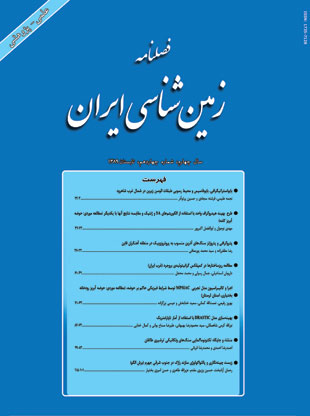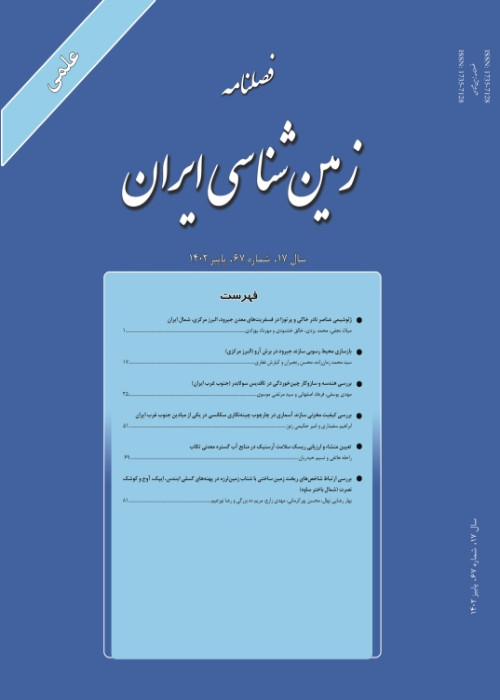فهرست مطالب

فصلنامه زمین شناسی ایران
پیاپی 14 (تابستان 1389)
- تاریخ انتشار: 1389/02/11
- تعداد عناوین: 8
-
-
Pages 3-21
Paleontological studies of the Ziarat and lower part of Karaj Formations in the Mojen area have been done. The study section, northwest of Shahrud, consists of limestone, sandy limestone, marly limestone, marl and gypsiferous marl with a thickness of about 101 meters. At the study section, the Ziarat Formation underlain conformably by Fajan Formation. A total of 48 species of foraminifera (distributed among 30 genera) were recognized in this study. Therefore, Ziarat Formation can be dated as Ypresian and Karaj Formation can be dated as Lutetian. One biozone (Cuvillierina eocenica range zone) was regionally established and five informal biofacies identified as follows: 1) Miliolidae – Rotalidae – bioclast, 2) Alveolina – Miliolidae – Orbitolites, 3) Alveolina – Nummulites, 4) Nummulites – bioclast, 5) Nummulitidae – Discocyclinidae. Based on these 5 biofacies, deposition may have taken place in a carbonate ramp. The stratigraphic position and index foraminifera reveal that just E1 (Ypresian) of the Ziarat Formation is present at the Mojen section. Abundance of large size flosculinized Alveolina implies a warm humid climatic condition during deposition of the Ziarat Formation (Ypresian) in the Mojen section.
-
Pages 23-31One of the most important steps in analysis of hydrology and produce design hydrographs is Unit Hydrograph. Unit hydrograph is used for determination of flood in storms with different duration and intensity. This paper presents an optimization model of producing unit hydrograph using SA (Simulated Annealing) Algorithm and Genetic Algorithm. Gamma, Log-normal and First passage time probability distributions are used in this study. In this model, the objective function is to minimize the sum of squares of the deviation between predicted and actual direct runoff hydrographs per unit area of the watershed. The predicted direct runoff hydrograph per unit watershed area is estimated using unit hydrograph and probability distribution function. Also there are no constrains in the optimization model using SA and Genetic algorithms and probability distribution functions, and the number of variable to be estimated by optimization is equal to probability distribution parameters. So, the proposed method is a simple method. Results show that Log-normal and First passage time distributions can be used to predict the peak discharge more or less correctly. Also comparison of obtained results from SA Algorithm and Genetic Algorithm show that SA Algorithm has better results in predicting optimal solution. Therefore, this model may be applied for quick and approximate estimation of unit hydrograph and simulation of runoff hydrograph.
-
Petrography and petrogenesis of igneous rocks attributed to Proterozoic within Ahangaran- Qayen areaPages 33-47The study area is located in Southern Khorasan Province, about 90 Km southeast of Qayen and 120 Km northeast of Birjand. The oldest rocks in this area, which are attributed to Proterozoic, consist of volcanic rocks and intrusive bodies with no sign of thermal metamorphic in volcanic rocks. Volcanic rocks include basalt, trachy-andesite and dacite, which have been metamorphosed to green schist facies. The compositions of the intrusive bodies attributed to Proterozoic ranges are diorite to granite. The magmatic nature of old volcanic rocks is mostly tholeiitic as these rocks in the area show a tholeiitic trend, and from thetectonomagmatic environment they belong to the tholeiitic oceanic island arcs. The magmatic nature of these intrusive bodies is sub-alkaline and the magma is of calc-alkaline type, therefore their tectonic settings belong to continental arc granite. These rocks in the studied area formed within active continental margin as a result of subduction phenomenon.
-
Pages 49-61Boroujerd plutonic complex is a part of Sanandaj – Sirjan structural zone which is located in western Iran. The dominant lithologic units are granodiorite that accompanied with small a –quartz diorite and monzogranitie stocks. The purpose of this research was to study the microstructure in this complex zone. Based on microscopic studies of microstructures, four type of microstructures have been identified: 1-magmatic microstructures, commonly observed in south–west of complex where its known as a Goosheh, 2-high–temperature solid–state microstructures observed in east and south–east toward the center of complex, 3- low–temperature solid–state microstructures in center, which are extended toward the west and south–west and finally 4- mylonitic to submylonitic microstructures that are extended from center to the north. Concentration of deformation intensity in north and west of complex can be attributed to existence of shear zones and faults in these regions, while magnetic microstructures in Goosheh granite indicate that tectonic forces could not affected these rocks, which can be correlated with their age that are young.
-
Pages 63-71The purpose of this study is to verify and evaluate the error generation parameters in MPSIAC model in the Bakhtiary Basin (NE Andimeshk), then modify the model for some parts of the basin. Estimation of erosion and sediment yield in this watershed was achieved using the empirical MPSIAC model. Therefore, this model was processed in a GIS environment and the results were compared with hydrometric stations (Tang-Panj, Zardfahreh, Ghalyan and Kazem-Abad). The result of MPSIAC model in Tang-Panj station has no distinct difference with the observed data and is calibrated directly with station data. However, there are many differences between the observed and computed results in Kazem-Abad station. For calibration of this basin, some schemes should be used. Therefore, probable errors in resources were identified and initial generating error parameters were verified. Finally, some corrections were done on error resources (vegetation coverage) which improved and calibrated the MPSIAC results and then calibrated. For evaluation of this correction, the outcomes were checked in two similar basins Ghalyan and Zardfehreh.
-
Pages 73-82Assessing the vulnerability of groundwater is an effective tool to identify vulnerable areas and conservation activities in order to maintain water quality in these areas. DRASTIC method has been used for vulnerability assessment more than other methods in scale area. The weakness of this method is estimating the weights of the model parameter. The aim of this research is to optimize the weights of DRASTIC model by using statistical nonparametric method. In this regard, the appropriate inputs of DARSTIC model were collected from Dezful area, and then vulnerability of the groundwater of this area was determined based on the primary weights of the model parameters. The final weights of the parameters were optimized using nonparametric test and the concentration of the nitrates in Dezful area. Results show better performance of optimized DRASTIC model than original DRASTIC model.
-
Pages 83-99Alborz Tertiary magmatic activity is mainly attributed to the subduction of Neo-Tethyan oceanic slab; however, the details, such as the source of magmas, are poorly understood. In this resaerch, on the basis of major and trace element geochemistry of Tertiary volcanic rocks from Taleghan, the mantle source characteristics of the volcanic rocks are investigated and a tectonomagmatic model is proposed. Tertiary volcanism in the Taleghan area, as a part of central-western Alborz magmatism, embrace a sequence of mainly basic volcanic rocks that are overlain the Karaj Formation subunits. The Tertiary volcanic sequence in the Taleghan is, from bottom to the top, as follows; 1-basalt-analcime bearing basalt unit, 2 tephrite unit and 3- olivine basalt-trachy basalt unit. The first two units demonstrate the geochemical characteristics of active continental margin volcanics derived from an enriched lithospheric mantle while olivine basalt-trachy basalt unit show the geochemical characteristics of intraplate volcanics derived from asthenospheric plumes. The coincidence of lithosphereic and asthenospheric mantle sources in petrogenesis of Taleghan volcanic rocks is the likely consequence of a postorogenic extensional (relaxation) geodynamic.
-
Pages 101-115
In order to study biostratigraphy and paleoecology of the Razak Formation, the type locality about 37 km southwest of Jahrum, was selected. Thickness of the Razak Formation at type section is 500 meters that conformably overlies the limestone of the Asmari Formation and is overlain by the Mishan Formation. 20 genera and 27 species of foraminifera and 2 faunal assemblages were recognized. As a result, the Razak Formation is Chattian Aquitanian (Late Oligocene–Early Miocene) in age. Association of carbonate grains of the Razak Formation at type section, considering presence of large benthic foraminifera accompanied with other accessory skeletal grains such as bryozoan, corallinacean algae, echinoid and gastropod and lack of colonial corals and green algae can be classified in foramol and heterozoanassemblages.


